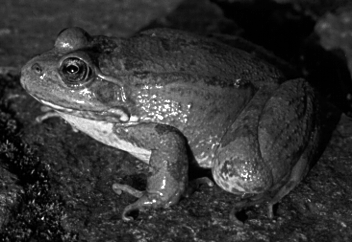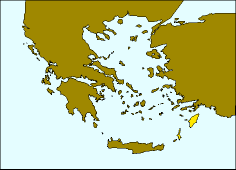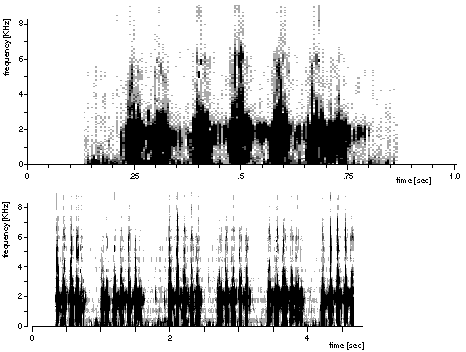![[Previous Taxon]](../PBimages/icons/previous.taxon.gif)
![[Next Taxon]](../PBimages/icons/next.taxon.gif)

![[Enclosing Clade]](../PBimages/icons/enclosing.clade.gif)
![[Deep Enclosing Clade]](../PBimages/icons/deep.enclosing.clade.gif)

![[Table of Contents]](../PBimages/icons/table.of.contents.gif)
![[Bottom of Page]](../PBimages/icons/down.arrow.gif)
![[water frog home page]](../PBimages/icons/frog.home.gif)
![[water frog page species list]](../PBimages/icons/frog.species.gif)
![[Under Construction]](../PBimages/icons/page.construction.gif)

Rana cerigensis Beerli, Hotz, Tunner, Heppich, and Uzzell 1994
Peter Beerli
Table of Contents
 Description
Description
 Distribution
Distribution
 Voice
Voice
 Synonyms
Synonyms
 References
References
Description
Excerpt of the original description:
A member of the western Palearctic water frog group,
distinguished from the Palearctic brown frog group by paired external lateral
vocal sacs in males, extension of webbing of feet to the toe tips, absence of a
black face mask from the eye to the tympanum, and presence of dark mottling on
the inner thigh surfaces; distinguished from the eastern Palearctic water frog
group by protein electrophoresis: among the loci sharing no alleles with
eastern Palearctic water frogs, those at aGDH, LDH-B, sMDH, MPI, and
6PGDH are shared with one to several species of western Palearctic water frogs,
whereas those at LDH-A, mMDH, and sSOD are shared with all. Rana
cerigensis is discriminated from all other western Palearctic water frog
species by a unique multilocus combination of electrophoretically detected
alleles: among alleles shared with other species, our samples are fixed for
mACO b, sACO b, ALB b, CK-A b, EST-6 b,
[[alpha]]GDH b, GPI d, sIDH b, mIDH c, LDH-B
a, sMDH b, MPI q; 6PGDH e, PGM-2 d, sSOD
a. Except that they segregate in the water frog population of Rhodos,
Rana cerigensis has unique alleles, fixed in our sample, for sAAT
(l) and AHH (c). Morphologically (Fig. 3), among western
Palearctic water frogs Rana cerigensis is medium-sized (mean ±
SD of body length 54.5±12.2 mm for 8 adults). Tibia relatively long
(body length/tibia length 1.85±0.08, N=8). Callus internus relatively
short (body length/callus internus length 18.5±2.2, N=7), of medium
height (callus length/height 3.2±0.3, N=3). Digitus primus medium-sized
(body length/digitus primus length 7.4±1.1, N=7; digitus primus
length/callus internus length 2.5±0.3, N=7). Dorsal coloration light
brownish gray to olive, with or without light brown spots. No vertebral stripe
in our samples. Venter cream-colored with gray mottling. Vocal sacs of males
dark gray. The advertisement calls of males (Fig. 2B,D; subsequent values are
mean±SD and refer to water temperature 20°C, air temperature
18°C) are produced in series, with call durations of 341±44 msec
and very short intercall intervals (276±54 msec). The calls consist of a
relatively low number (6.0±0.9) of pulse groups, with durations of
57±5 msec and group intervals of 41±15 msec, that comprise a
large number (>100) of pulses. In contrast to Rana cretensis, no
further level of amplitude subdivision of the pulse groups was observed.
Distribution
The distribution of this species is restricted to Karpathos and Rhodos (Greece). It is the only water frog species known so far on these islands. Problems concerning Rhodos are discussed in Beerli 1994

Voice
The following recordings a short sequences of longer recordings. These files are size reduced
(MULAW 8-bit encoded) from 16-bit encoded sound files.
[will come]

Synonyms
Valid name: Rana (Pelophylax) cerigensis Beerli, Hotz, Tunner, Heppich, and Uzzell 1994
Synonyms: -
References
Beerli H. Hotz, H. Tunner, S. Heppich, and T. Uzzell. 1994. Two new water frog
species from the Aegean islands Crete and Karpathos
(Amphibia, Salientia, Ranidae). Notulae Naturae, Academy of
Natural Sciences of Philadelphia 470:1-9.
[see full text]
Beerli, P. 1994. Genetic isolation and calibration of an average protein clock in
western Palearctic water frogs of the Aegean region. Dissertation
Universität Zurich 1994. [Summary]
Title Illustration
Rana cerigensis (The photo represents the paratype MHNG 2543.93).
Photographs copyright © 1995, Peter Beerli.
About the map
The map is a transverse Mercator projection
and was created with GMT 3.0 (
Wessel and Smith, 1995) and postprocessed in Virtuoso on a NeXT, and then converted from eps to gif.
[If you need maps, take a look at GMT 3.0 and create them yourself]
About this page
Peter Beerli
e-mail: beerli@scs.fsu.edu.
Genetics 357360
University of Washington
Seattle WA 98195-7360
USA
Page copyright © 1995
Peter Beerli
 Last modified 20 December 1995
Last modified 20 December 1995
![[Tree Help]](../PBimages/icons/help.gif)
![[Tree of Life Home Page]](../PBimages/icons/world.home.gif)

![[Tree of Life Root]](../PBimages/icons/root.gif)
![[Express Page]](../PBimages/icons/express.gif)

![[Top of Page]](../PBimages/icons/up.arrow.gif)
![[water frog home page]](../PBimages/icons/frog.home.gif)
![[water frog page species list]](../PBimages/icons/frog.species.gif)
Tree of Life design and icons copyright © 1994 David Maddison and Wayne Maddison



Last modified 20 December 1995